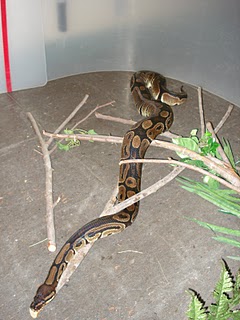 Snakes are undoubtedly one of the most feared animals in the world (although several African cultures revere Ball Pythons as being sacred). Still, more often than not snakes are seen as terrifying pests, which is exactly why I chose Ball Python #1 to be the animal highlighted in this month’s Creature Feature.
Snakes are undoubtedly one of the most feared animals in the world (although several African cultures revere Ball Pythons as being sacred). Still, more often than not snakes are seen as terrifying pests, which is exactly why I chose Ball Python #1 to be the animal highlighted in this month’s Creature Feature.
Ball Python #1 is a gentle 5 foot long female who weighs almost 6 lbs. and has been at the museum since 1993. She was found in someone’s backyard and brought to us in hopes that we could give her a home. Since Ball Pythons (also known as Royal Pythons) are only found in West Central Africa, it was apparent she was a pet that had somehow found a way out of her enclosure. Ball Pythons are very popular as pets because they are one of the smallest python species and are also very docile. She is now used as an education animal because of these same qualities.
The picture above shows Ball Python #1 in an exercise ring with sticks and fake leaves that she can move around on. She is known to be a terrific escape artist when in the ring by crawling up over the walls, so she requires almost constant supervision by the keepers when she’s exercising!
As you can also see in the picture, Ball Pythons have beautiful skin patterns. Typically the background color is a dark brown with tannish to yellowish blotches spanning the body. Although Ball Pythons are known to be one of the most popular snakes to keep as pets, most people are often unaware of how long they live. Their average wild life span is 20-30 years, with the captive life span being around 40 years!
They eat primarily rodents such as jerboas, rats and gerbils in the wild. We feed Ball Python #1 two large mice a week which are previously frozen (a safer method for the snake so that it does not get bitten) and then thawed out in warm water before being offered to her. Putting the mice in warm water helps to imitate a live mouse because Ball Pythons (along with several other species of snakes) have heat-sensing pits, or holes, that line their jaws and help them to hunt by feeling the heat coming off their prey.
When they locate their prey, they grab it and hold onto it with almost 100 inward-pointing teeth while killing it by constricting. Then they swallow their prey whole using their jaws and throat muscles to push the food down, without chewing or tearing it apart at all. If you’ve never seen a snake eat before, it’s really quite fascinating. You can see it up close at our Snake and Alligator Feeding Program every Thursday at 4:00 pm. Come check it out!
Can you see the heat-sensing pits in this picture of Ball Python #1? Click on the picture to get an even better view.
The facts in this post, along with much more information about Ball Pythons, can be found at http://www.hoglezoo.org/animals/view.php?id=28 and http://tinyurl.com/ysbeod
I thought that you might be interested in this recent Discovery News article about how snakes hear: http://dsc.discovery.com/news/2008/02/21/snake-hearing-ear
Cool, thanks Jeff!
The pic of the heat sensing pits is really cool!
Thanks Katchee, I thought that picture would be cool for anyone who has never seen heat sensing pits before (and even for people who have).